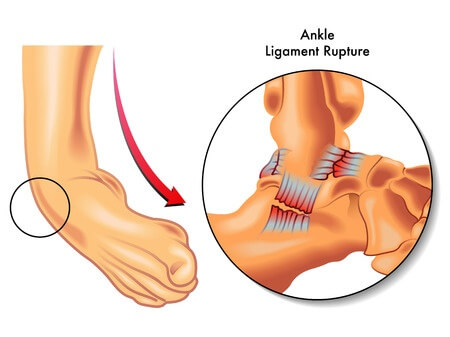What Really Happens You Sprain Your Ankle?

A sprained ankle, also known as a rolled ankle, is a very common injury that people from all walks of life suffer every day. But how does a sprain occur? Fundamentally, a sprained ankle is the result of the ankle ligaments supporting the ankle overstretching and tear. It can be caused by rapidly changing directions, treading a ball or just clumsily rolling your ankle while walking along the street. After getting over the initial shock, pain and possible embarrassment of spraining your ankle, one of the first questions that come to mind is: ‘Can I still continue playing sport or doing this exercise?’ But what really happens when you sprain your ankle? Knowing the type and severity of the sprain helps indicate whether you can continue playing and what kind of management required.
Types Of Ankle Sprains:
Inversion Sprain
The most common type of ankle sprain. This form of “rolled ankle” occurs when the ankle rolls inwards, causing the ligaments on the outside of the ankle to overstretch (anterior talofibular ligament, calcaneofibular ligament, posterior talofibular ligament).
Eversion Sprain
Occurs when the ankle rolls outwards and overstretches the ligaments on the inside of your ankle. When you sprain your ankle in this manner, the deltoid ligament is placed under great stress.
Though not as common, it is important not to immediately rule out more serious ankle injuries such as syndesmosis sprains (high ankle sprains), broken bones or avulsion fractures. These types of injuries require more aggressive management and can take over 3 months to return to playing sport.
Determining The Severity of An Ankle Sprain
A grading system helps determine the severity of the sprain and gives a rough guideline on when to return to sport.
Grade 1 Ankle Sprain
Involves stretching and microscopic tears of the ligament fibres. There will be mild tenderness and swelling around the ankle joint. Return to sport after this injury has a relatively quick turnaround, typically ranging from approximately 1-2 weeks.
Grade 2 Ankle Sprain
Involves partial tearing of the ligament(s), moderate tenderness and swelling and an abnormal looseness in the joint. Return to sport requires a more significant period of rest and recouperation before returning approximately 3-6 weeks after initial injury.
Grade 3 Ankle Sprain
Involves a complete tear of the ligament(s), significant tenderness and swelling and substantial instability in the joint. This may also be known as a rupture. You may be immobilised in a boot and surgery may be required in some cases. It can take over 4 months to return to sport following a grade 3 ankle sprain, but this depends on the management required.

What Happens After I Sprain My Ankle?
You can expect some swelling to occur within the first 3 hours after the injury, and this can continue to increase over the next 72 hours to a varying degree. It is not recommended to play sport during this time, but to instead ice, compress and elevate it.
When Can I Return To Sport After Spraining My Ankle?
The type of sport you play and the priorities of your team also affect the decision in when to return to sport. It is safest to return once you have full range of motion, stability and balance in order to prevent recurrence. A comprehensive rehabilitation program is required to achieve these goals, along with manual therapy to help increase mobility. Ankle sprains have one of the highest recurrence rates; therefore it is important to be cleared by your practitioner to return to sport in order to prevent re-injury.
